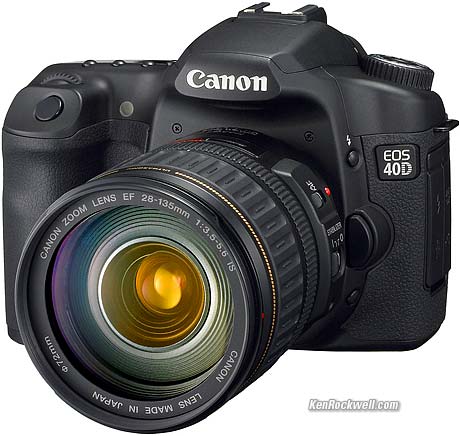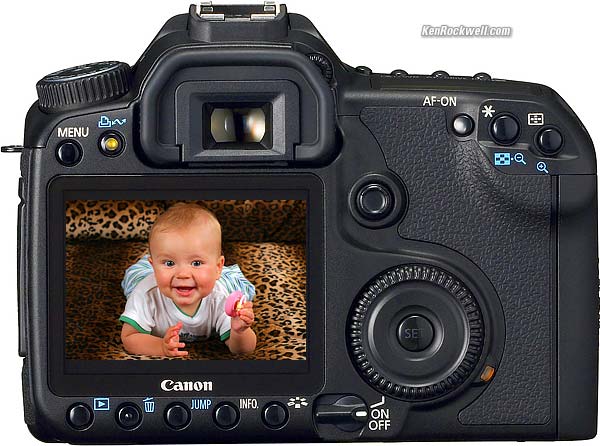|
I personally buy from Ritz, Adorama and Amazon. I can't vouch for any other ads.
|
© 2007 KenRockwell.com
I got my 40D from Adorama. I also use use Ritz and Amazon, and it helps me to keep adding to this site when you get yours from these links, too.
I just got one in my hot little hands, so this page will be growing daily. Skip down to the previous critical dry-lab analysis if you want polished reading.
12 October 2007: Canon 40D Highlight Rendition
The 40D also has more weather sealing than my 5D. For instance, the CF card door has foam seals while my 5D doesn't.
Metering seems smarter. Instead of having to dial down -2/3 stop in daylight, the 40D seems to be happy most of the time at 0. Your taste will vary.
03 October 2007: DSLR High ISO Shoot-Out
30 September 2007 Update:
I finally got some stick time with the new Canon 40D during a workshop I volunteered to teach yesterday in San Diego's Laguna Mountains. Of course I shot a bunch of head-to-head shots against my Canon 5D which I'll be sharing later this week, but that's unimportant.
The 40D just gets out of your way better and faster than its very similar predecessors with almost identical specs. The 40D just feels and works better. The 40D excels at the things for which there are no specs, but are immediately appreciated by anyone who spends all day with a camera stuck to their face.
What became immediately apparent is how fast, smooth, quiet and refined the 40D is compared to my 5D or the 20D or 30D. Even if it felt the same, the 3" LCD screen alone would be enough to justify the 40D to any full-time shooter.
Actual photographers, whom I'll define as anyone who makes at least a few hundred shots every day, at least 5 days a week, every week, will LOVE the 40D over the previous 10D, 20D or 30D. For them, it's a no-brainer. (see also Is It Worth It?)
Here are the obvious improvements in the 40D over the 30D and 20D:
1.) Quieter. I thought so on the first shot I made on the 40D, and confirmed it comparing to my 5D, 20D and 30D: the 40D is much quieter than the others. It vibrates less in my hand. The 40D is smooooooooth! That says volumes about a camera. It sounds and feels good! It's fast and quiet.
2.) Feels Better. The 40D feels much better in my hand. Its cover is rubberier, not the nasty hard plastic of my 5D and the 20D and 30D. Its shape is subtly different, which makes a huge difference in comfort.
3.) Better finder. The 40D's finder has a much more legible bottom display. (The size and brightness and AF stuff is the same as the 30D.) The previously illegible bottom green numbers are now bigger and more legible. The ISO is also now included in the finder.
All these are immediately obvious before playing the first image. Hit play, and:
4.) Hugely improved LCD. Whoops? Did I forget the 40D's great LCD monitor? The monitor of my 5D and the 30D are the worst in SLR photography because they are worthless and weak. The old LCDs are dim, have low contrast and have hideous color accuracy. The 3" LCD of the 40D is two or three classes above the crappy LCDs in the 5D and 30D. (The LCD of the 20D was better than the 30D, but it's only half the size of the 40D, so the 20D feels like 1999 all over again.)
The 5D may have some image quality advantage since it's full-frame, but far more obvious when shooting the same thing with both cameras is the blinding differences between the screens.
My 5D may make slightly sharper images if you're printing six feet (2 meters) wide, but the LCDs on the back of the cameras are vastly different. The 40D's LCD is big, bold, bright and vivid, while my 5D's LCD is dim, off-color and crappy. The nasty green-cyan tinge of the 30D and 5D's LCDs are very obvious next to a 40D. The 30D is exactly as bad as my 5D. (see LCD screen comparisons for examples.)
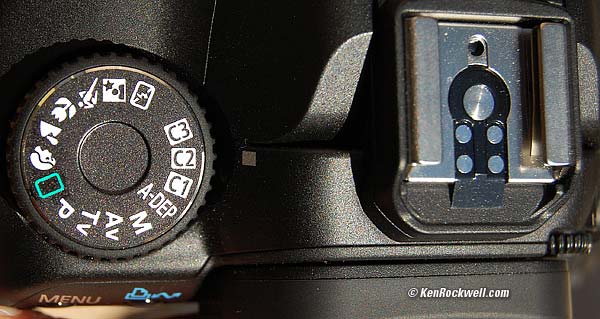
See the C1, C2 and C3 settings? These are complete setup memories!
5.) Three complete instant-recall camera-state memories. The 40D has three memories that store every camera setting. Every means every menu option, every custom setting, every ISO, Exposure Mode, Exposure Compensation, Image Size, Image Quality, WB, all of 9 the Parameters settings etc. and more are saved. These are the C1, C2 and C3 settings of the top left mode dial. My 5D has only one of these and I wish it had more. The 20D and 30D have none.
If you go to MENU > Wrench 3 > Camera User Setting > Register, you can store everything about the camera's current settings to any of these three positions. Now any time you go to either of the three C1, C2 or C3 positions, absolutely everything about the camera's setup is instantly restored. I use one of these settings for my manual studio strobe setup, others use them to save Live View or self timer and mirror up settings, etc. These are a huge help to anyone who works with the camera often. The only gotcha is that they also store the P, Tv, Av or M mode, and once you've recalled a setting, you cannot change that mode since if you turn the knob you've just returned to the previous camera state.
Screw my stupid upcoming comparisons of noise and resolution which are mostly of interest to people who prefer to talk about cameras instead of use them. If you use your camera enough for this to matter to you, then run, don't walk, and go get one or two 40Ds. It's soooooo obvious when you get the 40D and one of the other cameras together to compare, especially if you're intimate enough with at least one of them to notice what's changed. These ergonomic differences are obvious to me, since I have a camera stuck to my face all day. I'm very sensitive to anything that's changed, so if I shot with the 10D, 20D or 30D, I'd junk them yesterday and replace them with 40Ds.
Except for the various full-frame-advantages of the 5D, the noise levels of the 40D are visually identical to my Rebel XTi and the sharpness at ISO 200 is pretty close to my 5D. Who cares? Most photographers don't, but people who waste all day talking about it on the Internet do. The biggest technical quality differences between cameras are your ability to adjust the color and contrast to fit your scene and your artistic vision of it.
If the few hundred extra dollars for the 40D is a stretch, I'd avoid looking at the 40D since you're going to want it over the 30D or anything else from Canon. The final image quality is almost indistinguishable from the other Canon cameras, so don't worry if you can't swing a 40D.The final results will be the same; it just not quite as much fun with the older cameras.
I still need to analyze and publish the results, but I can't seen any technical difference between images from the 40D and my Rebel XTi. At ISO 200, the 40D also looks almost as good as my 5D except for the finest details and the ability to shoot fisheye and ultra-ultra wide.
If you shoot a lot, the 40D is easily worth the extra $300 today over a new 30D. If you don't shoot that much or don't have the extra $300, don't worry about it. (If you see the 40D's screen you'll be hooked, so don't look!) If money matters between getting a new 30D vs. a new 40D, ask yourself what you expect the difference in resale value to be when you go to sell. I suspect you'll get much of the difference back, since the used value of a 30D is based on the 30D already being a 2-year old model today.
Data: Oddly, dropping a card formatted in my Nikon D200, the 40D drops all its shots into the most recent xxxND200 folder instead of creating a new Canon folder.
Good news is that the 40D does a great job of displaying Nikon D200 files. The Canon 40D reads color space, exposure, ISO, time and date, exposure mode and meter mode of the files shot with the D200. It also can play, pan and zoom them as well as if they were shot on the 40D. Whoo hoo!
25 September 2007 Update:
Canon 40D Color and Contrast Adjustment Range Examples.
The 40D formats my 4GB SanDisk Extreme IV cards immediately, compared to my 5D which takes several seconds. I format for each shoot, so this is a daily or more often occurrence which bugs me on my 5D.
The LCD monitor is greatly improved from the 5D and 30D. Colors are finally accurate, and the viewing angle is wide. It's about as bright at the Nikon D40, with slightly less, but very similar, angle of view. It's not as sharp as the Nikons, due mostly to the internal processing which has nothing to do with rated pixels.
The Canon 40D still uses retarded (slower and more cumbersome) logic in playback: you still need to press PLAY to zoom or swap images when an image pops up after shooting, and when the screen turns off, the next time you push PLAY, it's back at the most recent photo. This is Hell if you just spent a minute scrolling back 143 images to the one you wanted to see, showed it around, and then the 40D times out on you. Nikons do it right and let you drive the camera as soon as the image pops up, and pop back where you were the next time you hit PLAY.
Depth-of-field preview button still on wrong side of 40D (needs a second hand to use), but now harder to find by feel.
22 September 2007 update:
I have not yet read the big user's manual, so many things I've not figured out. Read accordingly.
First observations are:
Mine is firmware version 1.0.3.
Quiet operation! It's very refined and smooth. I love it! It's lightweight, much lighter feeling than my D200. The covering feels like stickier rubber (good), or maybe it's just new and clean.
The finder is greatly improved. The numbers at the bottom are bigger and far more legible. ISO reads in finder, too.
Dirty Car ISO experiment
I found this weathered Coupe de Ville, so I couldn't resist.
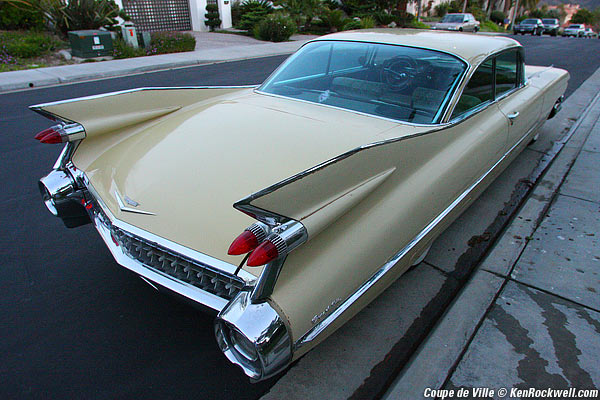
Coupe de Ville (1959 - 1964). As shot at dusk at ISO 3,200; 14mm f/2.8 L, shade WB (which is still way too blue).
Here are crops from 100% images from the 40D, hand held. The image would be about 38" (1m) wide if you printed the whole thing at this magnification.
This is a weathered Caddy, not something from the podium at Pebble Beach. The crud you see on the chrome is history, not camera artifacts. This is a quick hand-held shoot and run shot, so focus varies from shot to shot, so don't obsess over sharpness from one to the other. I did shoot in 6-frame bursts and got hand-tremor free images for each.
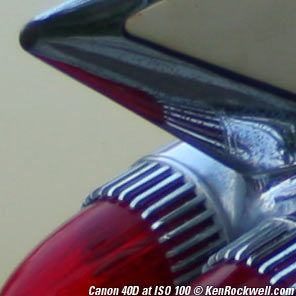 |
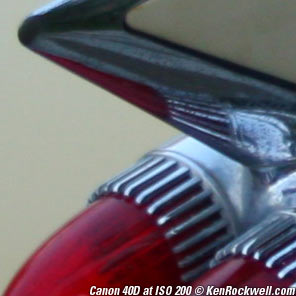 |
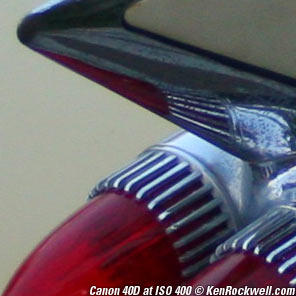 |
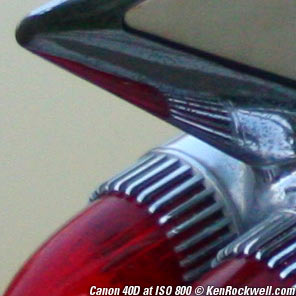 |
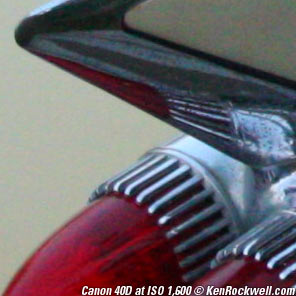 |
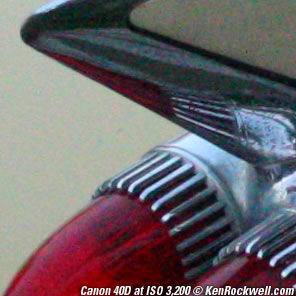 |
Shutter speed was 1/6 @ ISO 100, 1/10 @ ISO 200, 1/25 @ ISO 400, 1/30 @ ISO 800, 1/50 @ ISO 1,600 and 1/60 @ ISO 3,200 (aperture varied; closing down slightly at higher ISOs in Program mode).
Too many people waste too much time looking at irrelevant details like noise. Noise rarely gets in the way of good photos today, but wasting time worrying about it does.
All the above shots suck because the far more important issues of color and tone are wrong. It's too blue, too timid and and too dark. I'm unsure if the dead-cat ghetto sidewalk helps or hinders.
I used curves and saturation layers in Photoshop to fix this version, also from the ISO 3,200 shot.
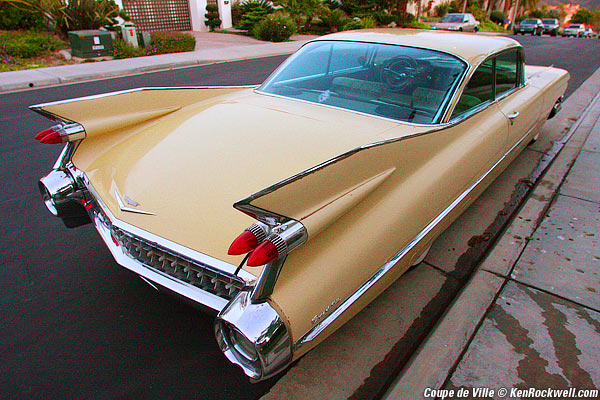
Coupe de Ville, arisen.
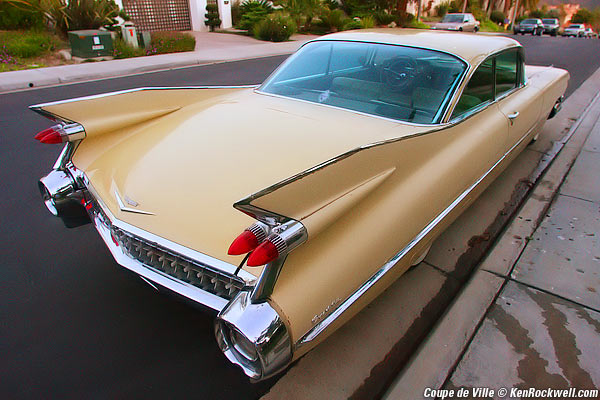
Coupe de Ville, arisen and massaged.
The extra saturation emphasized the ISO 3,200 noise, so this is the same 600 pixel wide image after running through the Grain Surgery plugin. I could have used the ISO 100 image, but I suspect you'd be more curious about the ISO 3,200 version.

Sucky "before" shot again for reference. I probably could have rectified this in-camera, but was in a hurry.
There are now three custom camera setting position memories on the top left dial (C1, C2 and C3.) I wish my 5D did this!!!
There are nine short menus instead of fewer long menus, reminiscent of the Canon Rebels. You must hit the JUMP button (or use the nubbin) to move to the next one. The menus are not long as they are on the 20D, 30D and 5D.
The Custom Functions are in their own menu, and they are broken into four submenus.
Custom functions now let me set ISO in full stops, yay!
Highlight tone priority is set in MENU > (JUMP to orange custom functions) > Spin wheel down to C.Fn II: Image > SET > C.Fn 3: Highlight Tone Priority > SET > Enable.
In Highlight Tone Priority, Canon's code words for extended highlight dynamic range, the ISO range excludes the lowest settings, and lo and behold, on in-camera playback, the ISO read back not as ISO 200, but ISO 2oo. I kid you not: in the extended dynamic range mode, the ISO plays back in-camera with ISOs read with little "o" instead of zeros.
To let the SET button be useful while shooting, go to MENU > (JUMP to orange custom functions) > Spin wheel down to C.Fn IV: Operation > SET > Spin to C.Fn 3 > SET > spin to your preference > SET
The LCD monitor is a disappointment, much worse that the Nikon LCDs. It's bigger, but not better than before. Resolution isn't very good, so text appears upscaled and smeared compared to even a $400 Nikon D40. The full LCD cannot be used to see the image: the top band is always data on black, not image. (I hope I'm missing a trick here.) Images seen on the monitor are not as sharp as the monitors on my current Nikons. That's not just the LCD screen's fault; the Nikons sharpen the image in firmware before display, the Canon 40D appears not to. The LCD's dots are coarse enough to see, not smooth and fine like other cameras.
AUTO ISO is idiotic. I can't get it to work as I want. Maybe I'm the idiot, I still need to read the manual. I see no way to adjust it as I can on every current Nikon. Sadly in Program mode it seems to go only between ISO 400 and 1,600; to get it to drop to ISO 100 I have to use other modes or come out of Highlight Priority.
Playback: now reads back sharpening, saturation, contrast and hue settings. Playback programming is still defective as my other Canons: you must hit the PLAY button before you can zoom or go forward and back. (Nikons do this properly.)
Sharpening, saturation, contrast and hue settings are the same as the 30D, Rebel XTi and 5D, which is, +/-4 for each. (Sharpening goes from 0 to 7.)
The power switch is still in the same place and does the same silly things.
Metering seems the same as my other Canon DSLRs: use -2/3 in daylight, neutral in flat indoor light.
Default JPG DPI: 72, as hoped. This doesn't matter to you, but often saves me a step when dropping text over images for the web.
August 20th, 2007
Top Intro Specs Performance Recommendations
The Canon 40D is exactly as we guessed: it's a 10 MP, 6.5 FPS, 3" LCD update of the Canon 20D and Canon 30D.
It's $1,299.99, you can order it today and it's available 10 September 2007.
The Canon 40D is the first significant update in Canon's mid-line DSLRs since the introduction of the 20D exactly three years ago in August 2004. (The 30D was an insignificant addition of a bigger, but less accurate, LCD and an RGB histogram compared to the 20D.) Therefore I'd skip the 30D and get a 40D instead for not much more money.
The 40D is a no-brainer today for anyone shooting sports and action. For $1,299, nothing on earth goes 6.5 FPS with this level of quality. I own a Nikon D200, but if sports were my thing, I'd rather have a Canon 40D.
What's New:
10MP up from 8MP, insignificant.
6.5FPS up from 5FPS, important for action.
New AF sensor. Same number of sensors, but better sensors.
3" LCD up from 2.5 or 1.8." Unknown if it's more color accurate than the 30D.
Better weather sealing.
Built in sensor cleaning like the Rebel XTi.
Canon 40D with 3" LCD.
Canon moved the buttons from the left to below the screen to make room. Note the new Hex button next to the power switch. I suspect it may give immediate access to the image color/saturation controls, cryptically called "Picture Styles" by Canon.
There's a new AF-ON button at the top right.
More buttons means faster operation and fewer menus. Yay!
Live View
The Canon 40D has the ability to flip up the mirror to see what's on the image sensor, live. Canon calls this "Live View" and it's only useful for manual tripod shooting, since autofocus doesn't work in Live View.
If you set a custom function and press the AF-ON button, the mirror flips down (cutting off live view), the 40D autofocuses, and then you can take your finger off the AF-ON button to resume live viewing on the LCD. Yes, you can get some AF in Live View, but no, you can't get them at the same time.
You can magnify the live image by five or ten times to check focus.
Live view adds a grid for helping get level shots.
Live view is also a mirror lock-up and slightly shortens the already minimal shutter delay. I'm unsure if you can use Nikon's ancient wide and fisheye lenses which poked into the camera with a Nikon-> Canon adapter. Good luck!
Live view also adds two quiet shooting modes, which can happen because the mirror is already up. This is advantageous for remote surveillance, since you can duct tape your 40D someplace it doesn't belong, and with the WFT-E3A wireless transmitter you can see what's going on and fire it from your laptop as you sit in your car . The images are transmitted to your laptop with the 40D not making much noise. If your target sees your 40D, you may lose your camera, but you've got your images and you're rolling before they see you. You also can do this with a USB cable, but it's not as stealthy.
Bigger, Better Finder
The 40D improves the finder by increasing the magnification from 0.90x to 0.95x, expanding the eyepoint (eye relief) from 20 to 22mm, and increasing the viewing angle from 251 to 264 degrees. I have no idea what they are talking about mentioning viewing angles of greater than 180 degrees, I'll bet someone dropped a decimal, but you get the idea: bigger and easier to see!
Highlight Rendition
I'm most excited about the new highlight processing ability.
Canon uses the clear-as-mud phrase "highlight tone priority custom function," which means better highlights if you want.
Digital cameras look digital because they rarely can handle highlights well. Highlights blow out and look like crap, especially with skin and stone tones. This is the biggest area which gets better with each generation of camera, but it's subtle and not obvious in camera lab tests or easy to measure, as flat-field noise and resolution are. Highlight handling is obvious even in 4x6" prints, while all the things that hobbyists worry about aren't.
Canon claims this custom function, which I think I would use all the time, has no speed penalty.
2,500K White Balance
Flying under most people's RADAR, Canon increased the range of manual Kelvin setting for WB to allow better images in dim interiors. Previous cameras only went to 2,800K, which gave me images that were still too orange in dim household lighting. Thanks Canon! (My Nikons with Kelvin settings all go to 2,500K.)
Top Intro Specs Performance Recommendations
Body: Specified as "magnesium alloy exterior," implying the frame is something less exotic.
Finder: 95% linear coverage. 0.95x magnification (50mm lens). Eye relief (eyepoint) 22mm. -3 to +1 diopter. Glass pentaprism, no eyepiece shutter.
Finder Info: (from Canon, my apologies if it's unclear): Focus confirmation dot, Shutter speed, Aperture, ISO, AE-Lock, EV compensation, Flash ready, flash exposure compensation, high-speed sync, FE-Lock, red-eye setting, B/W warning, Maximum burst, white balance correction warning, CF card information.
Optional Focus Screens: In addition to the standard screen, you can get a grid (Nikon has magic on-off grids in everything from the D80 up, standard, no new screen required), and you can get a special screen for the Canon 40D optimized for manual focusing of fast primes, which is unavailable for Nikon digitals.
AF: 9 cross points, work up to f/5.6. (Same points as 20D and 30D, but otherwise completely new.) Auto and manual selection. The central point offers extra precision at f/2.8 in both cross directions, a first in any Canon. Canon claims the "AF calculation speed" is 30% faster than the 30D, but that's fluff, since the calculation speed is only one part of many processes involved in the AF system.
You can see the selected sensor also on the top and rear LCDs as you set them.
AF Assist Beam: None, just Canon's usual hyper-annoying firing of the built in flash several times at your friends in the dark. I disable this in my Canons.
Metering: 35 zone evaluative, center weighted, and spot.
Custom Exposure Modes: Three. If these are the all-encompassing "C1, C2, C3" setting modes on the command dial, this feature alone would make the 40D worthwhile. I need to investigate.
Flash Metering: E-TTL II, identical to the 20D and 30D. New wireless remote control of the settings of the 580EX II.
Built-in Flash: Yes, covers 17mm lens, GN 13m/43' at ISO 100.
Maximum Shutter Speed with Flash: 1/250, normal sync.
Shutter: 30s - 1/8,000.
Shutter Death: Tested, but not guaranteed, to 100,000 cycles. I suspect if you can kill it under warranty, you're covered regardless of how many frames you get off.
Frame Rate: 6.5 FPS. The shutter and mirror have separate motors.
Buffer Depth: 75 JPG or 17 raw
Cable Release: Canon N3 terminal for things like the RS-80N3.
Image Sensor: 10.1MP CMOS, 1.6x crop factor, made by Canon. 22.5 x 15.0mm. 14-bit A/D conversion, bigger microlenses and new on-chip noise reduction electronics would suggest better high ISOs and lower noise.
Ultrasonic Sensor Cleaner.
Image Sizes: 3,888 x 2,592 native, also 2,816 x 1,880 (M) and 1,936 x 1,288 (S). Raw comes in your choice of 3,888 x 2,592 (raw) and 1,936 x 1,288 (s-raw).
ISO: 100 - 1,600 (ISO 3,200 turned on in a custom function).
White Balance: Auto, Direct Sunlight, Shade, Cloudy, Tungsten, Fluorescent, Studio Strobes, Custom gray/white card, and Kelvin (2,500 - 10,000K). The Kelvin range extends to 2,500K, better for use in dim interiors than the previous 2,800K limit. The 40D has the same +-9 settings for warm/cool and green/magenta as other Canons.
Color Spaces: sRGB (the world standard for photography) and Adobe RGB (for printing on printing presses; your colors will be dull if used for normal photography). See also sRGB vs. Adobe RGB.
File Formats: JPG, raw, s-raw (only 2.5MP) and JPG + raw.
S-raw is a reduced resolution raw with less than 2.5 megapixels. I pity the fool who uses s-raw to save file size: it has one-quarter the area resolution of JPG. S-raw throws away 75% of your pixels, while JPG throws away none.
You need a math PhD and an understanding of discrete cosine transforms, Huffman coding and quantization matrices to understand how JPG eliminates most of the file size but retains all the color depth and resolution of the original. JPG is the best way to compress file size.
Don't use s-raw unless you have a very, very good reason. S-raw lets you do all the color and exposure fiddling of raw, but with a fraction of the resolution. Use s-raw to experiment and learn, but I'd leave it alone otherwise.
S-raw is a very poor way to reduce file size and loses far more visible image quality than JPG, unless you're unskilled at initial photography. The reason you would want to use s-raw is if you are indecisive and want to adjust color and sloppy exposures after a shoot, but never intend to need the full resolution image again.
S-raw has its uses, but I caution the great majority of my readers for whom this s-raw feature is a bad idea. Then again, Bayer interpolation isn't involved in s-raw, so it's not as bad as you would think. S-raw (as well as small JPG) gives very similar results to what a similar Foveon sensor would give.
LCD: 3," 230,000 pixels. It's interesting to note that that is the same resolution as the 2.5" LCDs of the Rebel XTi, Canon 30D, Canon SD850 and Nikon D40, D40x, D80 and D200. A 3" LCD is 20% bigger in linear dimension than a 2.5" LCD, thus with the same resolution, a 3" LCD has 20% less linear resolution. In simple English, this 3" LCD shows the same detail and information as today's 2.5" LCDs, just bigger.
Storage: Compact Flash types I and II. with optional WFT-E3A you can plug in a USB hard drive and record to it.
Data Transfer: USB (standard) or wireless with optional WFT-E3A. Also an NTSC/PAL video output.
Included Software: I rarely use camera-company software, so here's the blurb copied from the press release: Among the most valuable features of the Canon EOS 40D Digital SLR is its compatibility with Canon's Picture Style Editor (PSE) 1.0 software. With PSE, shooters can actually design the look of their photographs by inputting their own preferred style, color and tone curves. The EOS 40D Digital SLR also ships with the latest versions of Canon's powerful software applications, including Digital Photo Professional 3.1 and EOS Utility 2.1, which now support the camera's Remote Live View and Dust Delete Data functions, as well as incorporating a broad range of additional improvements designed to improve image quality and speed up workflow. Also included are ZoomBrowser EX 5.8 and ImageBrowser 5.8 for easy browsing, viewing, printing and archiving with compatible computer operating systems, including Microsoft Windows Vista and Windows XP, as well as Mac OS X.Languages: 18: English, Japanese, German, French, Dutch, Danish, Portuguese, Finnish, Italian, Norwegian, Swedish, Spanish, Greek, Russian, Polish, Simplified/Traditional Chinese and Korean.
Power: BP-511A rechargeable lithium-ion and CG-580 charger, same as 30D, 20D and 5D. Rated 1,100 shots no flash and 800 with flash 50% of the time at room temperature. At freezing, Canon rates the 40D for 950 shots no flash, 700 with 50% flash. This is a lot! Clock backup: CR2016 rated 5 years.
The CG-580 charger is excellent. It's the same compact folding-plug (no cord) version as I got with my 5D. Its blinking light tells you 0%, 50%, 75% and 100% charge.
Size: 5.7 x 4.2 x 2.9" W x H x D, (145.5 x 107.8 x 73.5mm), rated.
Weight: 26.1 oz (740g), rated, usually stripped of battery, card, lens, etc.
Announced: 20 August 2007.
Shipping: Since the end of August, 2007. It's backordered, but already shipping to the first people who ordered it.
Price: $1,299 for the body, or $1,499 with Canon's classic 28-135mm IS. A new 18-55mm IS is also coming in October.
Included Accessories (USA):
Eb Eyecup
EW-100DGR Wide Strap
VC-100 Video Playback Cable
IFC-200U USB Cable
BP-511A Battery Pack
CG-580 Battery Charger (folding plug, no cord)
Software Disk and Instructions
"Great Photography is Easy" Booklet and "Do More with Macro" Booklet
Oddly, I see no mention of the instruction manual. I'm sure it's in there someplace, and might be the Great Photography book. Crap, if great photography is easy, I want a 40D just for the book! I work really hard to make great pictures.
Optional Accessories:
RS-80N3 Cable Release ($50!).
OSK-E3 Data Fidelity Verification Kit ($650!).
Eyepiece Diopters.
ACK-E2 AC adapter ($60).
BG-E2N high-capacity Battery Grip takes up to two BP-511A battery packs or six AA batteries. The BG-E2N grip features new sealing material around the battery compartment to better resist water and dust. The new model replaces the original BG-E2 grip and is compatible with the EOS 20D, 30D and 40D.
WFT-E3A wireless file transmitter. It allows wireless transfer and back-up, as well as remote control of the camera in Live View mode.
The WFT-E3A can be connected to a GPS or USB 2.0 external drives for instant back-up as you shoot. The WFT-E3A is also a vertical grip and requires its own BP-511A battery pack in addition to the battery installed in the camera body.
The WFT-E3A is still in the process of regulatory paperwork with the FCC [potential radio interference] and FDA [potential hazardous radiation] for legal sale in the USA.
Top Intro Specs Performance Recommendations
Pop open the card door while writing an image and it will sound an alarm not to screw with the card, but it will keep writing.
Top Intro Specs Performance Recommendations
For sports, if you don't have $4,500 for the 1D Mk III, get a 40D. Duh, for $1,299.99 brand new, don't even think about the 30D or used 20D.
For portraits and landscapes, I'm intrigued by the highlight processing of the 40D, but if you're serious, I love the concrete image quality advantages of my full-frame 5D. Of course the 5D costs about double the 40D if you didn't get a 5D on rebate in Fall 2006.
In a lab, I'll bet you that the image quality of the Rebel XTi is about the same as the 40D. The difference is that the 40D works faster, is built tougher, and the AF of the 40D ought to be more accurate and faster. Better AF can mean sharper pictures.




